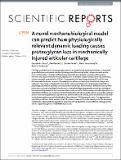A novel mechanobiological model can predict how physiologically relevant dynamic loading causes proteoglycan loss in mechanically injured articular cartilage
Author(s)
Orozco, Gustavo A.; Tanska, Petri; Korhonen, Rami K.; Florea, Cristina; Grodzinsky, Alan J
Downloads41598-018-33759-3.pdf (5.434Mb)
PUBLISHER_CC
Publisher with Creative Commons License
Creative Commons Attribution
Terms of use
Metadata
Show full item recordAbstract
Cartilage provides low-friction properties and plays an essential role in diarthrodial joints. A hydrated ground substance composed mainly of proteoglycans (PGs) and a fibrillar collagen network are the main constituents of cartilage. Unfortunately, traumatic joint loading can destroy this complex structure and produce lesions in tissue, leading later to changes in tissue composition and, ultimately, to post-traumatic osteoarthritis (PTOA). Consequently, the fixed charge density (FCD) of PGs may decrease near the lesion. However, the underlying mechanisms leading to these tissue changes are unknown. Here, knee cartilage disks from bovine calves were injuriously compressed, followed by a physiologically relevant dynamic compression for twelve days. FCD content at different follow-up time points was assessed using digital densitometry. A novel cartilage degeneration model was developed by implementing deviatoric and maximum shear strain, as well as fluid velocity controlled algorithms to simulate the FCD loss as a function of time. Predicted loss of FCD was quite uniform around the cartilage lesions when the degeneration algorithm was driven by the fluid velocity, while the deviatoric and shear strain driven mechanisms exhibited slightly discontinuous FCD loss around cracks. Our degeneration algorithm predictions fitted well with the FCD content measured from the experiments. The developed model could subsequently be applied for prediction of FCD depletion around different cartilage lesions and for suggesting optimal rehabilitation protocols.
Date issued
2018-10Department
Massachusetts Institute of Technology. Department of Biological Engineering; Massachusetts Institute of Technology. Department of Electrical Engineering and Computer Science; Massachusetts Institute of Technology. Department of Mechanical EngineeringJournal
Scientific Reports
Publisher
Nature Publishing Group
Citation
Orozco, Gustavo A., Petri Tanska, Cristina Florea, Alan J. Grodzinsky, and Rami K. Korhonen. “A Novel Mechanobiological Model Can Predict How Physiologically Relevant Dynamic Loading Causes Proteoglycan Loss in Mechanically Injured Articular Cartilage.” Scientific Reports 8, no. 1 (October 22, 2018). © 2018 The Authors
Version: Final published version
ISSN
2045-2322